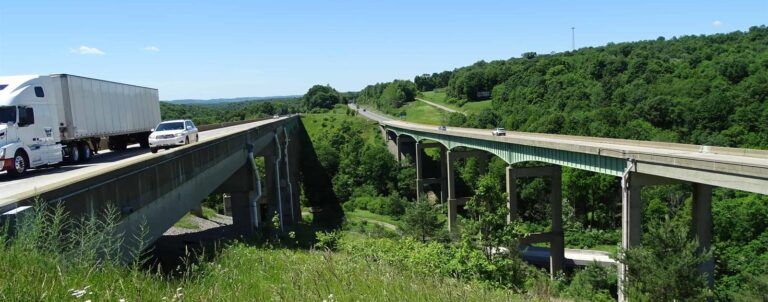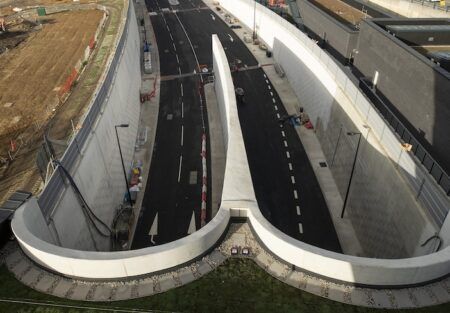As part of its study to explore sustainable transportation funding methods and completing critical projects, the Pennsylvania Department of Transportation (PennDOT) has announced the bridges being considered for its PennDOT Pathways Major Bridge Public-Private Partnership (P3) Initiative, and the coming industry opportunities to participate.
“Our reliance on funding models from the last century leaves us especially vulnerable to fund losses stemming from volatile economic conditions and the increasing transition to alternative- fuel or electric vehicles,” PennDOT secretary Yassmin Gramian said. “This initiative will help us make much-needed improvements without compromising the routine projects our communities and industry partners rely on.”
To support PennDOT Pathways, an alternative funding Planning and Environmental Linkages (PEL) study is underway to identify near- and long-term funding solutions for the overall transportation system and establish a methodology for their evaluation.
One of the early findings of the PEL study is that tolling of major bridges in need of replacement or rehabilitation appears to be a viable near-term solution. To advance this funding alternative, PennDOT is pursuing the first initiative of the PennDOT Pathways Program: The Major Bridge P3 Initiative.
The Pennsylvania P3 Board approved the Major Bridge P3 Initiative on November 12, 2020, which allows PennDOT to use the P3 delivery model for major bridges in need of rehabilitation or replacement, and to consider alternative funding methods for these locations.
Through the P3 model, PennDOT can leverage private investment to rebuild critical bridges during a period with historically low interest rates and a favorable labor market. This initiative can provide a dedicated source of revenue for these infrastructure improvements and could create significant savings over the life of the program while ensuring the vitality of the state’s transportation system and economy.
The bridges being considered for tolling through the Major Bridge P3 Initiative are structures of substantial size that warrant timely attention and would require significant funds to rehabilitate or replace. Additionally, these bridges were selected based on the feasibility of construction beginning in two to four years to maximize near-term benefits, and with the intention that their locations are geographically balanced to avoid impact to just one region. Projects being considered, and for which a public involvement process begins this spring, include:
- I-78 Lenhartsville Bridge Replacement Project (Berks County);
- I-79 Widening, Bridges and Bridgeville Interchange Reconfiguration (Allegheny County);
- I-80 Canoe Creek Bridges (Clarion County);
- I-80 Nescopeck Creek Bridges (Luzerne County);
- I-80 North Fork Bridges Project (Jefferson County);
- I-80 Over Lehigh River Bridge Project (Luzerne and Carbon counties);
- I-81 Susquehanna Project (Susquehanna County);
- I-83 South Bridge Project (Dauphin County); and
- I-95 Girard Point Bridge Improvement Project (Philadelphia County).
Each bridge’s project scope, surrounding roadway network, and traffic flow is being evaluated for inclusion in one or more project bundles to be advertised this spring. PennDOT is analyzing potential structures for project bundles to ensure fair, competitive, and local participation in the P3 procurement to replace these bridges and anticipates issuing a Request for Information to industry partners in the week of February 22 to gather industry feedback on the project, with a Request for Qualifications anticipated this spring. Private-sector partners can find a presentation outlining the anticipated process and project benefits on the Major Bridge P3 project page.

Bridge tolling provides funds to reconstruct or replace these costly bridges without depleting PennDOT’s ability to deliver its current program of projects, thus allowing existing funding to continue to be used for needed roadway and bridge safety and operational improvements. Tolling would be all electronic and collected by using E-ZPass or license plate billing. The funds received from the toll would go back to the bridge where the toll is collected to pay for the construction, maintenance and operation of that bridge.
Over the next year, PennDOT will evaluate these candidate bridges through individual environmental documents being prepared or re-evaluated for each bridge. More information on each individual bridge project, and when the public will have an opportunity to engage on those projects, can be found at www.penndot.gov/funding and on the project pages.
As Pennsylvania’s mobility needs have grown, the amount of funding required to support our highway and bridge network has continued to increase. PennDOT’s current highway and bridge budget for construction and maintenance is about $6.9 billion per year – less than half of the

$15 billion needed to keep Pennsylvania’s highways and bridges in a state of good repair and address major bottlenecks on our roadway network.
These are the latest in the agency’s efforts to support and grow the state’s transportation network in the face of growing needs and shrinking resources. Much of PennDOT’s current highway and bridge funding comes from gas taxes, which are declining due to alternative fuels and fuel efficiency. PennDOT Pathways aims to identify reliable, future-focused funding solutions that will meet the overall transportation system’s growing needs while serving communities. The PennDOT Pathways PEL study will evaluate additional alternative funding solutions and will be available for public comment in the spring.





